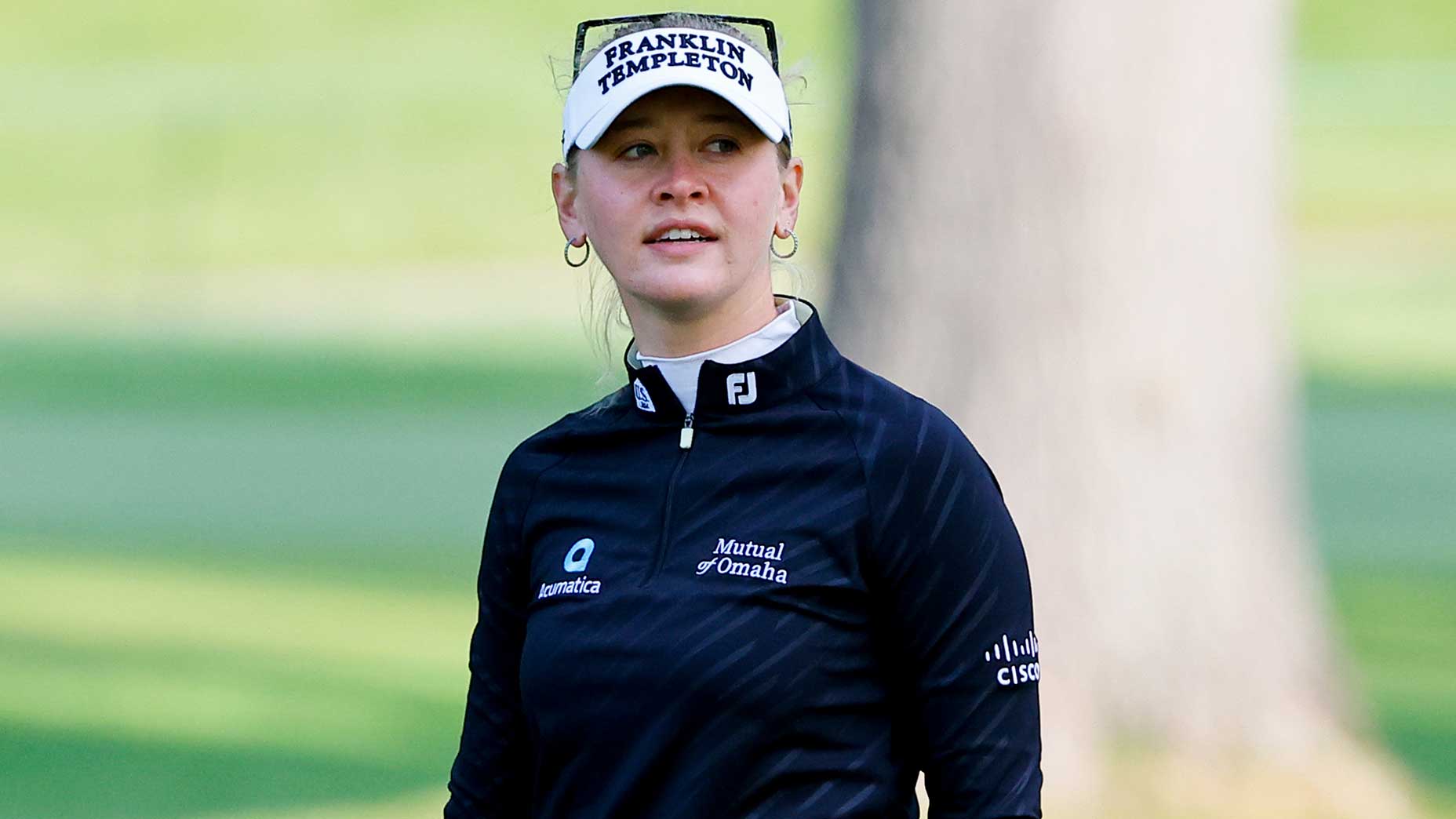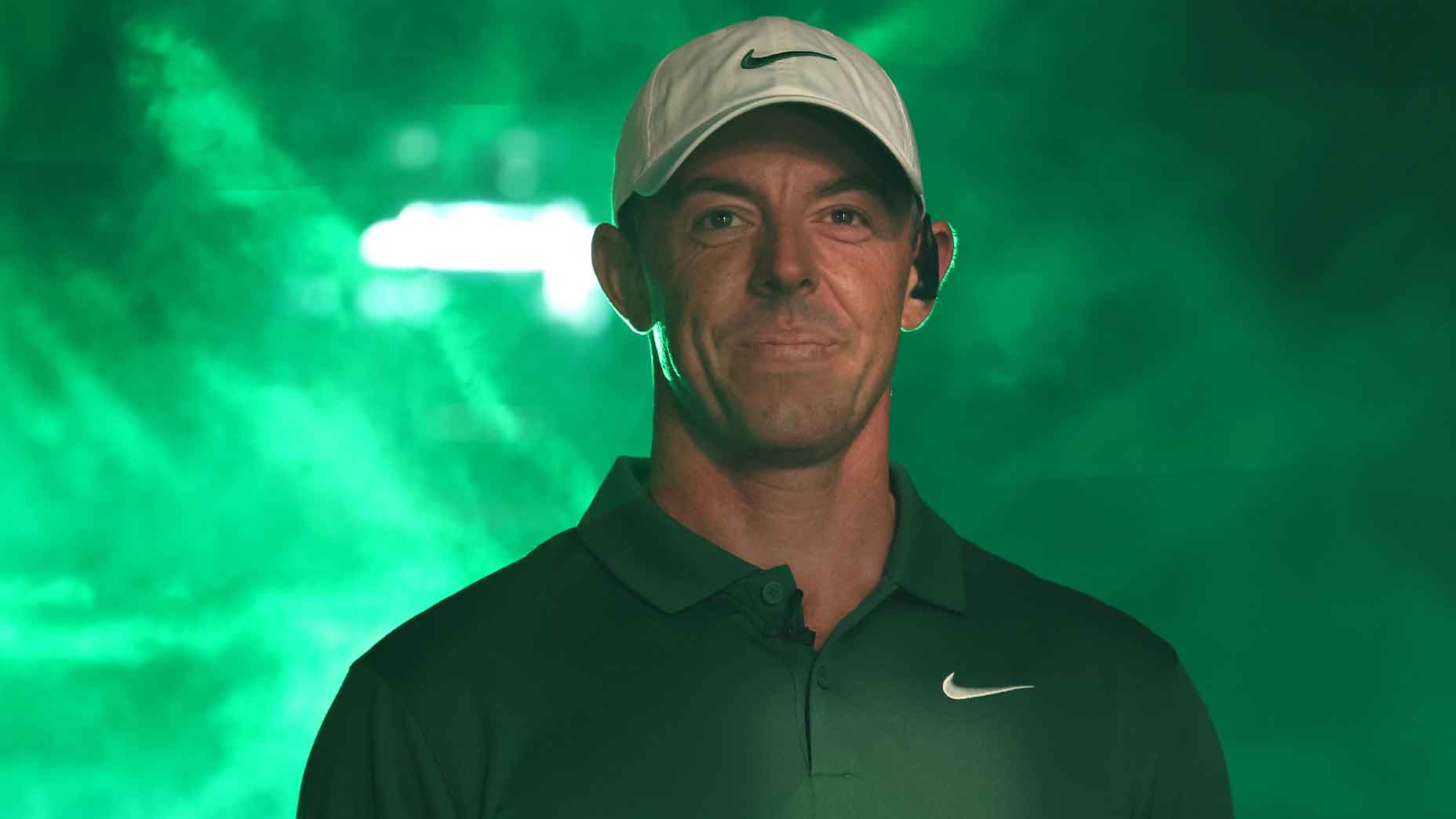On the day his golf course died, George Kelley arrived on the grounds worn down.
“I’ve been stressed out, sleeping badly and drinking to drown my sorrows,” he said. “It’s been like having a loved one on life support.”
Enough was enough. Time to pull the plug.
It was mid-July in California’s Central Valley. Morning had just broken, but the sun was set on broil. In the distance, cars approached, riding single file as if in a funeral procession, passing through a flat expanse of parched orchards and pasture, spilling toward a creek at the course entrance that once flowed deep but now ran dry.
Near the driving range, a fleet of carts awaited: one last 36-hole shotgun outing. Kelley stood before them in a collared shirt and shorts, looking like a starter but sounding like a pastor.
“This is a sad day,” he said into a microphone as players milled around him.
Some were men’s club members, grim-faced and despondent. Others claimed no close affiliation to the course, but being avid golfers, they felt a fellowship and had come to pay respects.
“It’s sad,” Kelley continued, “but let’s make this a celebration, a good old-fashioned Irish wake.”
Behind him lay the body of Stevinson Ranch, the big-boned layout that Kelley and his two brothers, Bob and Kevin, had built, with the architect John Harbottle, in 1995, on unirrigated farmland that his family had owned for generations. The course took its name from the Kelleys’ great-great grandfather James A. Stevinson, a Gold Rush-era migrant who settled in the valley in the early 1850s, while its design paid homage to George’s favorite courses, the grand links of Northern Ireland: Royal Portrush and Royal County Down. Pot bunkers pocked the fairways. Swales and hollows bucked and heaved around the greens.
In its first decade, the course had flourished, at once a local draw and a purist’s destination. A public track that Kelley kept in country-club condition, it played host to U.S. Open qualifiers and mini-tour events.

Those were the salad days, before the markets plunged and the rains stopped falling, before Stevinson devolved into a doubly dogged victim, battered by the downturn and then ravaged by the drought. Its plight is not an isolated story. All across the West, courses that had staggered through the financial crisis now face the consequences of the water shortage, a double-edged sword of soaring costs and use restrictions. When it comes to the color of fairways, brown is the new green—if you’re lucky. If not, you could go the way of Diablo Grande, Stevinson’s vaunted 36-hole cross-valley neighbor. Once an emblem of the boom it’s now a symbol of the bust, forced to close one of its layouts, in early 2014.
That Stevinson survived at all is thanks largely to Kelley, who struggled to sustain it even as its vital signs faltered. As the property bled money, he absorbed the losses. As the canal that fed the turf became a dusty culvert, he dipped into his reserves to dig a well. His annual water costs quintupled from $20,000 to $100,000, taking ever larger bites from a $2.5 million operating budget. Revenues dwindled, as greens fees dropped to $27 at a course that had commanded twice that 10 years earlier. Even at that bargain rate, rounds-played were roughly half what Kelley hoped they would be.
What he’d aimed to keep alive wasn’t just a course but a complex ecosystem of friendly bets and post-round banter and Sunday four-balls you could set your clock to: the sort of social elements that elevate a course into something greater than a patch of well-groomed grass.
All of that was dying, too.
Among those now left grieving is Matt Hansen, 35, a Central Valley kid and former PGA Tour pro who’d honed his skills at Stevinson. He owns the course record: a 59 he fired in 2005. That was a nice round, Hansen acknowledged, as he waited to light out on his farewell 18, but not as special as the one he interrupted, three years later, when he dropped to a knee on the 9th green and proposed to Megan. They’d met while he was playing his home track and she was breezing around on the beverage cart.
“My wife, my kids,” Hansen said. “Everything that’s good in my life, I owe to this place.”
Off went the carts, fanning out across the front and back nines, carrying the mourners and their memories. Les Acevedo, a real-estate agent and course stalwart, rode with his teen son, Landon, who’d started banging balls at Stevinson when he was barely taller than his father’s driver.
“Still hard to believe,” Acevedo said, looking at his boy, who plays to a plus-four and is off to Sacramento State in September on a golf scholarship.
For Dan Sellers, the recollections reached even further back. A longtime valley resident who now lives on the coast but had driven over this morning to say “so long,” Sellers remembered striking shots when the course was under construction, ground unseeded, a footprint in the dirt. Having known it in its glory and watching it mature into a youthful beauty, he found unexpected solace in the layout’s late-life state, fairways scruffy, bald spots on the greens.
“On the one hand, it’s tough to see it in this condition,” he said. “On the other hand, it almost makes it easier to move on.”
By mid-afternoon the sun had risen so high that the flagsticks cast no shadows. A logjam formed on the 5th tee. Dick Bork, the marshal, saw no need for urgent action. At 81, he’d lived long enough to know that time passed swiftly, so what was the point of making people rush?
“They’ll listen to me,” he said, “but only to a point.”
Besides, blame for the backup lay largely with the woman behind the wheel of the beverage cart, a cause for rubbernecking if ever there was one. Known to regulars as Foxy Roxy, a moniker she’d bestowed upon herself, Tiffani Castro was garrulous and funny, “heartache in a halter top,” as one gray-haired golfer murmured as she mixed a margarita. At least she was kind enough to let a guy down easy.
“Oh, come on now,” she said as a man tried out a line. “You’re old enough to be my dad.”
Twilight fell. Putts dropped in near darkness, so many groups concluding on so many holes at once that nobody could tell what counted as the final stroke. Wrapping up on 18, a par-5 he’d played more times than he could tally, Anthony Maxwell, ponytailed and sunburnt, doffed his cap and wiped away a tear.
“I haven’t made friends out here,” he said. “I’ve made brothers.”
They lived far from one another, and Stevinson was the tie that bound them. They’d play again together, somewhere, sometime, but, Maxwell said, it would never be the same.
Players moved on to a party in an open-air pavilion behind the 10th tee with a prime rib dinner and a live band. Worn out from a long day of condolences and thank you’s, George Kelley took the stage and grabbed a microphone.
“There are a lot of golf courses closing in America,” he said. “But there aren’t a lot of great ones. And what made Stevinson Ranch so great was all of you.”
Financially, the closure wasn’t going to break him. Emotionally, it was tearing him apart. Late last year, he and his wife, Carla, had built a home alongside the 12th hole. They had no plans to leave it, and that, he admitted, would be the really hard part. Kelley wasn’t sure whether he could stand it, staring out his window at a dead landscape, his golf course decomposing, dust to dust.
This article appeared in the most recent issue of SI Golf+ Digital, our weekly e-magazine. Click here to read this week’s issue and sign up for a free subscription.







